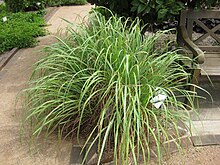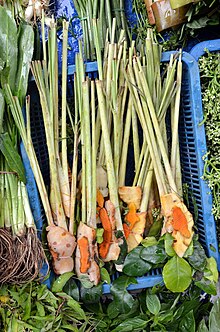Cymbopogon citratus
| Lemon grass | |
|---|---|

| |
| Scientific classification | |
| Kingdom: | Plantae |
| Clade: | Tracheophytes |
| Clade: | Angiosperms |
| Clade: | Monocots |
| Clade: | Commelinids |
| Order: | Poales |
| Family: | Poaceae |
| Subfamily: | Panicoideae |
| Genus: | Cymbopogon |
| Species: | C. citratus
|
| Binomial name | |
| Cymbopogon citratus | |
| Synonyms[2] | |
|
List
| |
Cymbopogon citratus, commonly known as West Indian lemon grass or simply lemon grass,[3] is a tropical plant native to Maritime Southeast Asia and introduced to many tropical regions.[4]
Cymbopogon citratus is often sold in stem form. While it can be grown in warmer temperate regions, such as the UK, it is not hardy to frost.
Morphology[edit]
Cymbopogon citratus is part of the grass family, Poaceae. They contain simple, bluish-green leaves with entire margins and are linear in shape. The blades tend to be 18–36 inches long. Like other grasses, the leaves also have parallel venation.[5]
Distribution[edit]
Cymbopogon citratus is native to Island Southeast Asia (Malesia). It has been introduced extensively to South Asia since precolonial times. After World War I, lemongrass was introduced to Madagascar, South America, and Central America. It has now been naturalized throughout the tropics and subtropics worldwide.[6]
In its native range, Cymbopogon citratus is known as sereh, serai, or serai dapur in Indonesia and Malaysia; and tanglad (from Proto-Austronesian *Caŋelaj originally referring to Themeda gigantea, a type of elephant grass[7]), salai, or balioko in the Philippines.[6]
Culinary uses[edit]


Cymbopogon citratus is abundant in the Philippines and Indonesia where it is known as tanglad or sereh, respectively. Its fragrant leaves are traditionally used in cooking, particularly for lechon and roasted chicken.[8]
The dried leaves can also be brewed into a tea, either alone or as a flavoring in other teas, imparting a flavor reminiscent of lemon juice but with a mild sweetness without significant sourness or tartness.
In Sri Lanka, lemongrass is known as sera (සේර). It is used as a herb in cooking, in addition to its use for the essential oils.[9]
Lemongrass in Thailand is called takhrai (ตะไคร้). It is the essential ingredient of tom yam and tom kha kai. Fresh thin slices of lemongrass stem also used in miangpla, as a snack food.
Medicinal uses[edit]
This section needs more reliable medical references for verification or relies too heavily on primary sources. (December 2015) |  |
The leaves of Cymbopogon citratus have been used in traditional medicine and are often found in herbal supplements and teas. Evidence of effective Cymbopogon citratus essential oil anti-protozoa activity against Leishmania amazonensis.[10]
Chemical composition[edit]
Lemon grass oil contains 65–85% citral in addition to myrcene, citronellal, citronellol, linalool and geraniol.[11][12] Hydrosteam distillation, condensation, and cooling can be used to separate the oil from the water. The hydrosol, as a by-product of the distillation process, is used for the production of skin care products such as lotions, creams, and facial cleansers. The main ingredients in these products are lemon grass oil and "negros oil" (mixture of lemon grass oil with virgin coconut oil) used in aromatherapy.[13]
Citronellol is an essential oil constituent from Cymbopogon citratus, Cymbopogon winterianus, and Lippia alba. Citronellol has been shown to lower blood pressure in rats by a direct effect on the vascular smooth muscle leading to vasodilation.[14] In a small, randomized, controlled trial, an infusion made from C. citratus was used as an inexpensive remedy for the treatment of oral thrush in HIV/AIDS patients.[15]
Laboratory studies have shown cytoprotective, antioxidant, and anti-inflammatory properties in vitro.[16][17][18]
Traditional medicinal use[edit]
In the folk medicine of the Krahô people of Brazil, it is believed to have anxiolytic, hypnotic, and anticonvulsant properties.[19][20]
In traditional medicine of India the leaves of the plant are used as stimulant, sudorific, antiperiodic, and anticatarrhal, while the essential oil is used as carminative, depressant, analgesic, antipyretic, antibacterial, and antifungal agent.
Effect on insects[edit]

Beekeepers sometimes use lemon grass oil in swarm traps to attract swarms. Lemon grass oil has also been tested for its ability to repel the pestilent stable fly,[21] which bite domestic animals.
See also[edit]
References[edit]
- ^ "Cymbopogon citratus". Germplasm Resources Information Network. Agricultural Research Service, United States Department of Agriculture. Retrieved 2008-03-02.
- ^ "The Plant List: A Working List of All Plant Species". Retrieved May 8, 2014.
- ^ USDA, NRCS (n.d.). "Cymbopogon citratus". The PLANTS Database (plants.usda.gov). Greensboro, North Carolina: National Plant Data Team. Retrieved January 12, 2019.
- ^ "Cymbopogon citratus". Plants of the World Online. Royal Botanic Gardens, Kew. Retrieved March 4, 2019.
- ^ Shah, Gagan; Shri, Richa; Panchal, Vivek; Sharma, Narender; Singh, Bharpur; Mann, AS (2011). "Scientific basis for the therapeutic use of Cymbopogon citratus, stapf (Lemon grass)". Journal of Advanced Pharmaceutical Technology & Research. 2 (1): 3–8. doi:10.4103/2231-4040.79796. ISSN 2231-4040. PMC 3217679. PMID 22171285.
- ^ a b Oyen, L.P.A. "Cymbopogon citratus (PROSEA)". Pl@ntUse. Retrieved 30 June 2019.
- ^ Blust, Robert; Trussel, Stephen (2010). "*Caŋelaj elephant grass, miscanthus grass: Themeda gigantea". Austronesian Comparative Dictionary. Max Planck Institute for Evolutionary Anthropology. Retrieved 8 November 2022.
- ^ "Tanglad / Lemongrass". Market Manila. August 21, 2006. Retrieved July 27, 2011.
- ^ "The Spice Council of Sri Lanka". www.srilankanspices.com. Archived from the original on 2011-03-23.
- ^ Santin, Marta Regina; dos Santos, Adriana Oliveira; Nakamura, Celso Vataru; Dias Filho, Benedito Prado; Ferreira, Izabel Cristina Piloto; Ueda-Nakamura, Tânia (2009). "In vitro activity of the essential oil of Cymbopogon citratus and its major component (citral) on Leishmania amazonensis". Parasitology Research. 105 (6): 1489–1496. doi:10.1007/s00436-009-1578-7. ISSN 0932-0113. PMID 19669793. S2CID 22754248.
- ^ Shaikh, Mosma; Suryawanshi, Yogesh; Digambar, Mokat (2019). "Volatile Profiling and Essential Oil Yield of Cymbopogon citratus (DC.) Stapf Treated with Rhizosphere Fungi and Some Important Fertilizers". Journal of Essential Oil Bearing Plants. 22 (2): 477–483. doi:10.1080/0972060X.2019.1613933. S2CID 191177588.
- ^ Baby P. Skaria; P.P. Joy; Samuel Mathew; Gracy Mathew; Ancy Joseph; Ragina Joseph (2007). Aromatic Plants. Vol. 1. New Delhi, India: New India Publishing Agency. p. 103. ISBN 9788189422455.
- ^ Inquirer.net, ‘Tanglad’ goes mainstream, yields essential oils Archived 2008-06-29 at the Wayback Machine
- ^ Bastos JF. Moreira IJ. Ribeiro TP. Medeiros IA. Antoniolli AR. De Sousa DP. Santos MR. (2010). "Hypotensive and vasorelaxant effects of citronellol, a monoterpene alcohol, in rats". Basic & Clinical Pharmacology & Toxicology. 106 (4): 331–337. doi:10.1111/j.1742-7843.2009.00492.x. PMID 20002067.
- ^ Wright SC. Maree JE. Sibanyoni M. (2009). "Treatment of oral thrush in HIV/AIDS patients with lemon juice and lemon grass (Cymbopogon citratus) and gentian violet". Phytomedicine. 16 (2–3): 118–124. doi:10.1016/j.phymed.2008.07.015. PMID 19109001.
- ^ Figueirinha A. Cruz MT. Francisco V. Lopes MC. Batista MT. (2010). "Anti-inflammatory activity of Cymbopogon citratus leaf infusion in lipopolysaccharide-stimulated dendritic cells: contribution of the polyphenols". Journal of Medicinal Food. 13 (3): 681–690. doi:10.1089/jmf.2009.0115. PMID 20438326.
- ^ Lee HJ. Jeong HS. Kim DJ. Noh YH. Yuk DY. Hong JT. (2008). "Inhibitory effect of citral on NO production by suppression of iNOS expression and NF-kappa B activation in RAW264.7 cells". Archives of Pharmacal Research. 31 (3): 342–349. doi:10.1007/s12272-001-1162-0. PMID 18409048. S2CID 20909743.
- ^ Tiwari M, Dwivedi UN, Kakkar P (2010). "Suppression of oxidative stress and pro-inflammatory mediators by Cymbopogon citratus D. Stapf extract in lipopolysaccharide stimulated murine alveolar macrophages". Food Chem. Toxicol. 48 (10): 2913–2919. doi:10.1016/j.fct.2010.07.027. PMID 20655974. S2CID 9395057.
- ^ Blanco MM, Costa CA, Freire AO, Santos JG, Costa M (March 2009). "Neurobehavioral effect of essential oil of Cymbopogon citratus in mice". Phytomedicine. 16 (2–3): 265–70. doi:10.1016/j.phymed.2007.04.007. PMID 17561386.
- ^ Rodrigues, Eliana & Carlini, E.A. (2006): Plants with possible psychoactive effects used by the Krahô Indians, Brazil. Revista Brasileira de Psiquiatria 28(4): 277-282. PDF fulltext Archived 2020-08-01 at the Wayback Machine
- ^ a b Baldacchino, Frédéric; Tramut, Coline; Salem, Ali; Liénard, Emmanuel; Delétré, Emilie; Franc, Michel; Martin, Thibaud; Duvallet, Gérard; Jay-Robert, Pierre (2013). "The repellency of lemongrass oil against stable flies, tested using video tracking". Parasite. 20: 21. doi:10.1051/parasite/2013021. ISSN 1776-1042. PMC 3718533. PMID 23759542.
